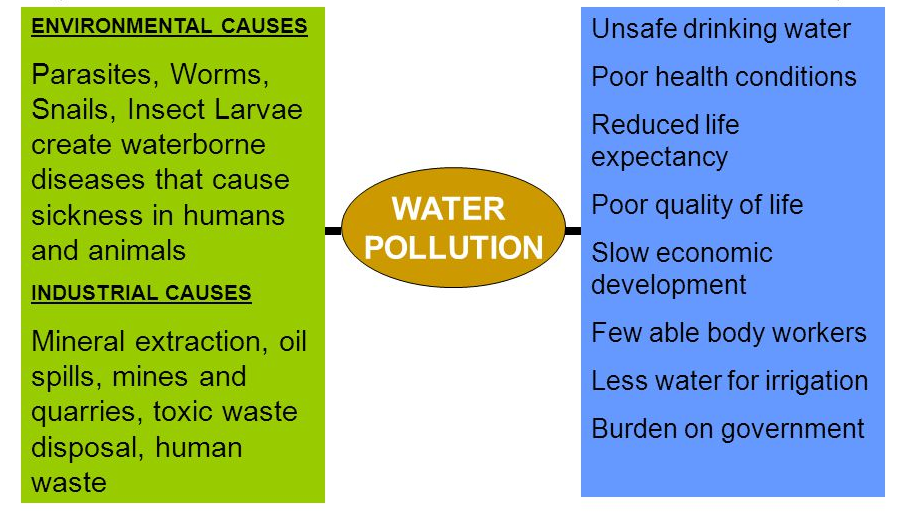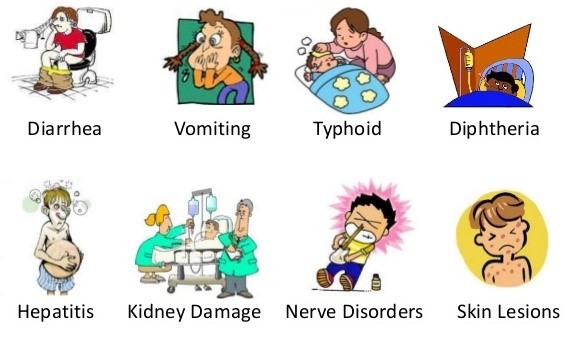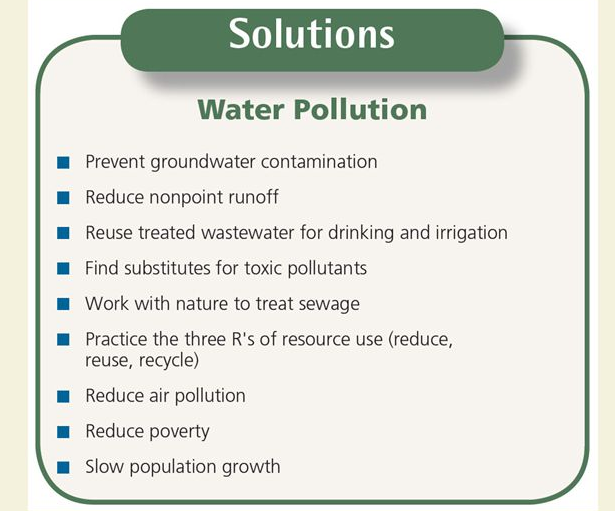Water Pollution
Table of Content |
Definition of Water Pollution
The contamination of water bodies such as oceans, rivers, lakes, aquifers etc., is known as Water Pollution. Water pollution is one of the major problem that is spreading globally. It has been reported that about 14,000 people die daily due to water pollution. About 90% of cities in china are water contaminated.
Sources of Water Pollution
There are two sources of water pollution:
- Point Sources are those sources which arises from single, identifiable source. For Example, pipe or ditch.
Fig. 1. Sources of water pollution
- Non-point sources are those sources that arises from diffuse contaminants from more than one point or source. For example, nutrient run-off from the agriculture land.
Causes of Water Pollution
The causes of water pollution are divided into:
- Pathogens that causes water pollution
- Organic, inorganic, and macroscopic contaminants
- Thermal solution
Fig. 2. Causes and effects of water pollution
Pathogens that Causes Water Pollution
Coliform bacteria is an indicator of water pollution. There are various bacteria that causes contamination in water such as:
Organic, inorganic, and macroscopic contaminants
Organic Contaminants Include:
-
Detergents
-
Insecticides and herbicides used during agriculture practices.
-
Food processing waste.
-
Volatile inorganic compound etc.
Inorganic contaminants include:
-
Sulphur dioxide from power plants.
-
Nitrates and phosphates found in the fertilizers. Adding more nutrients to the water can cause decrease in oxygen dissolved in water which leads to growth of algae known as algal blooms. This process is known as Eutrophication.
-
Chemical waste from industrial by-product.
-
Acid drainage.
-
Heavy metals such as lead, cadmium, mercury etc. causes toxic water pollution. Cadmium causes lung cancer, mercury causes nausea, nephrotic syndrome, and lead causes anemia etc.
Macroscopic Contaminants
-
Garbage such as plastic, paper, or any food waste. Plastic is non-biodegradable contaminant, so it remains in the environment for a long period of time.
-
Remains of the ships.
-
Chemical waste from industries.
-
Food processing waste.
Thermal Pollution
-
Thermal pollution changes the properties of the water.
-
Urban run-off raises the water temperature.
-
Elevated temperature decreases the oxygen level in water, causing death of living organisms.
-
Power plants causes thermal pollution.
Effects of Water Pollution
-
Death of aquatic animals due to depletion of oxygen.
-
Imbalance of ecosystem.
-
Contaminated water causes various diseases. Polluted water causes some of the deadly diseases like cholera, dysentery, diarrhea, tuberculosis, jaundice, etc. Approximately 80 per cent of diseases associated with stomach in India are caused by polluted water.
Fig. 3. Diseases caused due to water pollution
-
The amount of dissolved solid is a very important indicator of suitability of water for drinking, irrigation, and industrial uses. Water with total dissolved solids of less than 500 mg/litre are most fit for drinking.
-
Thermal pollution causes organisms to become physiologically stress or they sometimes die when exposed to heated water. It also depleted the oxygen level in water.
Methods to Detect Water Pollution
Water pollution can be analyzed by – Physical, Chemical, and Biological methods.
Physical tests include solid concentration and turbidity of water.
Chemical methods of analysis include pH measurement, nutrients in water, toxic metals in water, biological oxygen demand and chemical oxygen demand.
Biological methods include use of plant, animal, bacteria as an indicator of water pollution.
Methods to Control Water Pollution/Water Pollution Solutions
-
Sewage treatment is one of the method to control water pollution. Construction of toilets and pits will promote sewage treatment.
-
Wastes should be treated before discharge.
Fig. 4. Methods to detect water pollution
-
Water Hyacinth (Eichhornia crassipes) are used to treat wastewaters. Water hyacinth is not only used to treat domestic waste but also industrial waste. It easily absorbs, heavy metals such as lead, cadmium, mercury, and nickel.
-
Ion Exchange is also one of the method to control water pollution. Ion exchange is method of exchanging of two ions in a solution.
-
Reverse Osmosis is also another method for controlling water pollution. It is a method of purification of water via semipermeable membrane.
-
Precipitation is also used to control water pollution. Dissolved contaminants are transformed into an insoluble solid.
-
Recycling is another method to control water pollution.
You can also refer to Organic Chemistry Revision Notes and IIT JEE Chemistry Syllabus
To read more, Buy study materials of Environmental Chemistry comprising study notes, revision notes, video lectures, previous year solved questions etc. Also browse for more study materials on Chemistry here.
Watch this Video for more reference
More Readings
View courses by askIITians


Design classes One-on-One in your own way with Top IITians/Medical Professionals
Click Here Know More

Complete Self Study Package designed by Industry Leading Experts
Click Here Know More

Live 1-1 coding classes to unleash the Creator in your Child
Click Here Know More

a Complete All-in-One Study package Fully Loaded inside a Tablet!
Click Here Know MoreAsk a Doubt
Get your questions answered by the expert for free





